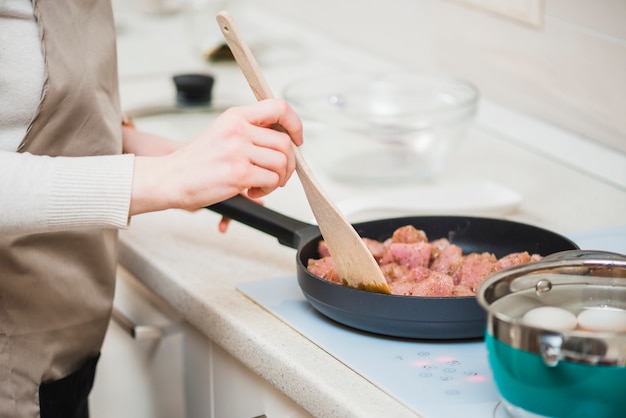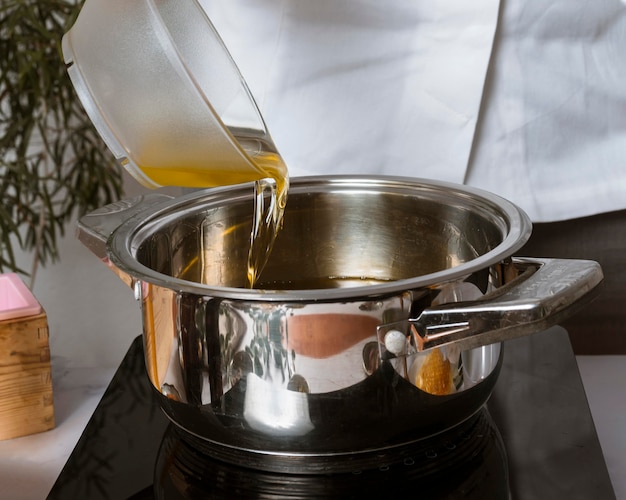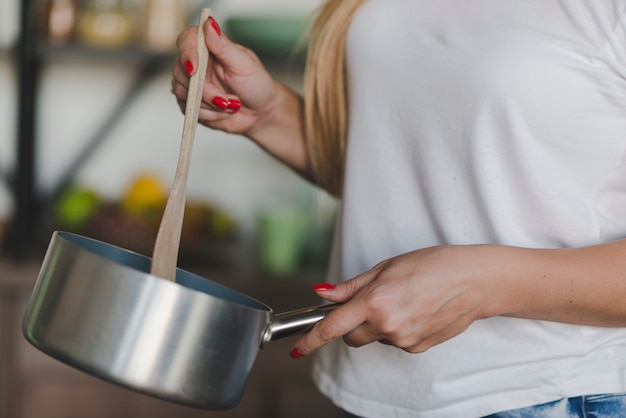For years, I swore by my trusty cast iron skillets. They were my culinary workhorses, capable of searing steaks to perfection and baking bread with a satisfyingly crusty exterior. But lately, I've been captivated by the sleek allure of stainless steel cookware. The gleaming surfaces, the precise control over heat, the promise of even cooking – it all beckoned to the perfectionist in me. So, I embarked on a journey to master the art of cooking with stainless steel pans, and what a journey it's been!
(Part 1)
Choosing the Right Pan: A Foundation for Success

The first step was finding the perfect pan. The sheer variety available was overwhelming – from budget-friendly options to high-end brands boasting unique features. After much research and deliberation, I decided to start with a set of three: a small saucepan, a medium-sized skillet, and a large stockpot. This offered versatility for a wide range of cooking needs, from simmering sauces to searing steaks to preparing hearty soups.
Key Considerations for Selecting a Stainless Steel Pan
Here are some key points to keep in mind when choosing your stainless steel pan:
- Thickness: Opt for pans with a thick base and sides, as these ensure even heat distribution and prevent hot spots.
- Construction: Look for a pan with a "tri-ply" construction, where aluminum is sandwiched between two layers of stainless steel. This combination delivers excellent heat conductivity while maintaining the durability and aesthetic appeal of stainless steel.
- Handle: Choose a pan with a sturdy handle that feels comfortable to grip, even when the pan is hot.
- Lid: A well-fitting lid is essential for steaming and simmering. Look for a lid that has a tight seal and is made of heat-resistant glass or stainless steel.
Understanding Stainless Steel's Quirks: A Different Kind of Cooking

My initial ventures into stainless steel cooking were met with some frustration. Everything seemed to stick to the pan, even after I thought I had seasoned it properly. But then it hit me – stainless steel is a different beast altogether. You can't simply toss your ingredients into a hot pan and expect them to cook flawlessly. This is where technique comes in. One of the most crucial things I learned was that proper preheating is key. Allow the pan to get really hot before adding any oil or ingredients. This creates a hot enough surface for the food to sear and release easily.
The Importance of Proper Preheating: A Crucial First Step
Here's a simple test to ensure your pan is preheated correctly: Put a few drops of water in the pan. If the water beads up and dances around before evaporating, your pan is ready. If the water just sits there and steams, it's not hot enough. This preheating ritual may seem tedious, but trust me, it makes a world of difference in the end result.
cooking techniques for Stainless Steel: Mastering the Basics

Stainless steel cookware offers a unique set of challenges and rewards. Here are some key techniques to master:
1. The Art of Sautéing: Achieving a Beautiful Sear
Sautéing is a classic technique that involves cooking food quickly over high heat. It's a great way to achieve a beautiful sear on meat or vegetables, bringing out their natural flavors and creating a crispy exterior. But with stainless steel, you need to be mindful of the temperature. Too low, and the food will steam instead of browning. Too high, and it could burn. The trick is to find that sweet spot. I found that using a good quality oil with a high smoke point, like avocado or grapeseed oil, is crucial. Also, avoid overcrowding the pan; give the food space to brown evenly.
2. Mastering the Art of Stir-Frying: Speed and Precision in Action
Stir-frying is all about speed and precision. It's a technique where you quickly cook food over high heat in a wok or a large skillet. You need to keep the food moving constantly to prevent it from sticking or burning. This technique calls for a well-seasoned stainless steel pan, one that's been preheated to a high temperature. For stir-frying, I find a generous amount of oil is essential, enough to create a thin layer that coats the bottom of the pan and allows the ingredients to glide effortlessly.
3. Steaming in a Stainless Steel Pot: Gentle and Moist Cooking
Contrary to popular belief, stainless steel is also excellent for steaming. Its ability to conduct heat evenly makes it ideal for creating a gentle and moist cooking environment, preserving the nutrients and vibrancy of vegetables while keeping them light and tender. I use a steamer basket that sits inside the pot, allowing the steam to circulate freely around the food.
Maintaining Your Stainless Steel Pans: Keeping Them in Top Condition
Over time, even the most well-made stainless steel pans can show signs of wear and tear. But with proper care, you can keep them in top condition for years to come.
1. The Importance of Hand Washing: Gentle Cleaning for a Lasting Shine
While some stainless steel pans are dishwasher-safe, I prefer to hand wash mine. This allows me to avoid the harsh detergents and high temperatures that can dull the finish. I use warm, soapy water and a non-abrasive sponge to gently clean the surfaces. For stubborn food residue, I use a bit of baking soda, which is a natural cleaning agent and leaves a sparkling finish.
2. Keep Your Pans Looking Their Best: Avoiding Damage and Discoloration
To prevent rust and discoloration, I dry my stainless steel pans thoroughly with a clean towel after washing. I also avoid using steel wool or abrasive scrubbers, which can scratch the surface. If a pan shows signs of discoloration, I use a stainless steel cleaner. But I make sure to read the instructions carefully, as some cleaners can leave behind a residue.
FAQs: Common Questions Answered
You may have some questions about using stainless steel cookware. I've compiled some common questions and answers to help you navigate the world of stainless steel:
| Question | Answer |
|---|---|
| How do I season a stainless steel pan? | You don't need to season a stainless steel pan in the same way you do a cast iron pan. The key to preventing sticking is proper preheating and using enough oil. |
| Can I use acidic ingredients in a stainless steel pan? | Yes, but be mindful of the fact that acidic ingredients can cause discoloration. It's best to avoid using acidic ingredients for long periods of time or at high temperatures. |
| How do I prevent food from sticking to the pan? | Proper preheating is crucial! Also, use enough oil and don't overcrowd the pan. Make sure to deglaze the pan after cooking, which helps to remove any remaining food particles. |
| What are some good brands of stainless steel cookware? | There are many good brands out there, but some popular ones include All-Clad, Calphalon, and Le Creuset. |
| How long do stainless steel pans last? | With proper care, stainless steel pans can last for decades. |
(Part 2)
Beyond the Basics: Exploring Advanced Techniques
Once you've mastered the fundamentals of stainless steel cooking, you can delve into some more advanced techniques. These techniques can help you unlock new culinary possibilities and elevate your cooking skills to the next level.
1. Deglazing the Pan: Transforming Leftovers into Sauce
Deglazing a pan is a technique that involves adding liquid, such as wine, broth, or water, to the pan after cooking. The liquid dissolves the flavorful bits that are left behind, creating a delicious sauce that captures the essence of the dish. Deglazing is a technique that comes in handy for a wide range of dishes, from simple weeknight meals to elegant restaurant-worthy creations.
2. sous vide cooking: Precise Temperature Control for Tender and Juicy Results
Sous vide cooking involves sealing food in a vacuum bag and immersing it in a water bath at a precise temperature. This method ensures that the food cooks evenly, producing tender and juicy results. It's particularly beneficial for cooking meat, poultry, and fish, but it can also be used for vegetables and eggs. While a dedicated sous vide circulator is needed for this technique, it's a worthy investment for those seeking to elevate their culinary game.
3. The Art of Mastering the Pan: From Sautéing to Frying
A stainless steel pan can be your go-to tool for a variety of cooking methods. From simple pan-frying to more advanced techniques like braising and roasting, a well-seasoned pan can handle it all. The key is to understand the characteristics of each technique and how to adjust your cooking method to achieve optimal results.
My Experience: From Beginner to Confident Cook
My journey with stainless steel cookware has been a rewarding one. I've gone from being a beginner who was intimidated by the idea of using these pans to a confident cook who now enjoys experimenting with new recipes and techniques. It's been a process of learning, adapting, and ultimately, discovering a new level of culinary creativity. I've learned that patience and practice are key. Don't be afraid to experiment and make mistakes. That's how you truly master the art of cooking.
(Part 3)
The Joy of Cooking with Stainless Steel: More Than Just a Pan
As I've progressed on my stainless steel journey, I've come to realize that it's not just about the cookware itself. It's about the entire experience. There's something incredibly satisfying about witnessing the transformation of raw ingredients into a delicious meal in a pan that heats evenly and responds to every change in temperature. It's about the precision, the control, the artistry. It's about feeling like a true chef in your own kitchen.
Beyond the Kitchen: The Beauty of Stainless Steel
And let's not forget the aesthetic appeal of stainless steel. The sleek, modern look adds a touch of sophistication to any kitchen. I love how these pans reflect the light, creating a sense of warmth and vibrancy. They're not just functional tools; they're works of art that elevate the entire cooking experience.
The Legacy of Stainless Steel: From Grandma's Kitchen to Yours
There's a sense of history and legacy that comes with using stainless steel cookware. These pans have been passed down through generations, serving as a testament to the enduring quality and timeless appeal of this material. They're a reminder of the simple pleasures of home-cooked meals, of family gatherings, and of the joy of sharing food with loved ones.
So, if you're looking to elevate your cooking game, I highly recommend exploring the world of stainless steel cookware. Embrace the challenge, learn the techniques, and enjoy the journey. It's an investment in your kitchen, your skills, and your culinary creativity. It's an investment in the art of cooking.
Everyone is watching

Prime Rib Roast Cooking Time Chart: Per Pound Guide
Cooking TipsPrime rib roast. Just the name conjures images of lavish dinners, crackling fires, and hearty laughter. It’s ...

How Long to Bake Potatoes in the Oven (Perfect Every Time)
Cooking TipsBaked potatoes are a staple in my kitchen. They're incredibly versatile, delicious, and surprisingly easy to m...

Perfect Rice Every Time: The Ultimate Guide to Cooking Rice
Cooking TipsAs a self-proclaimed foodie, I've always been a bit obsessed with rice. It's the foundation of countless cuisi...

The Ultimate Guide to Cooking Asparagus: Tips, Techniques, and Recipes
Cooking TipsAsparagus. The mere mention of this spring delicacy conjures up images of vibrant green spears, crisp and burs...

Ultimate Guide to Cooking the Perfect Thanksgiving Turkey
Cooking TipsThanksgiving. Just the word conjures up images of overflowing tables laden with delicious food, the scent of r...
